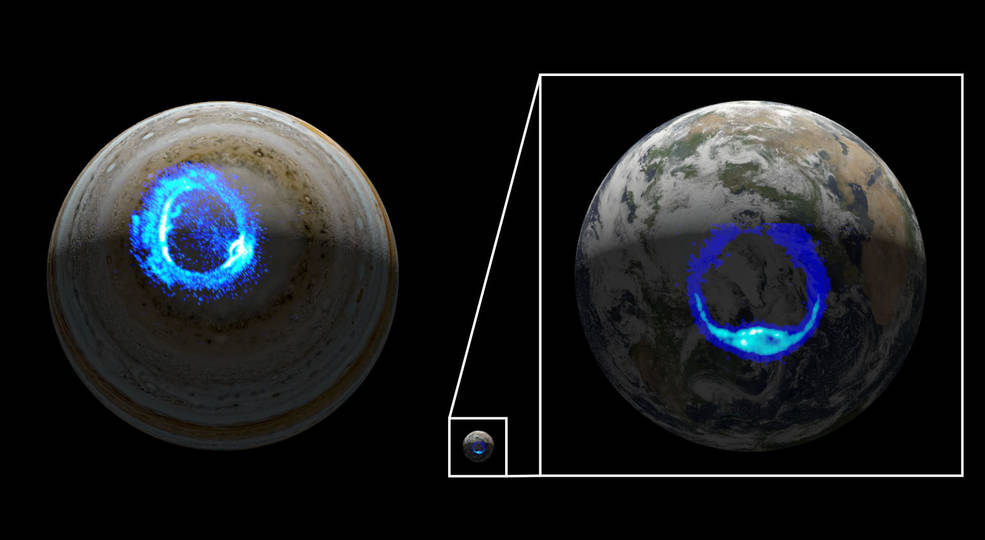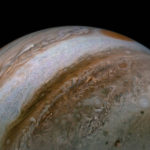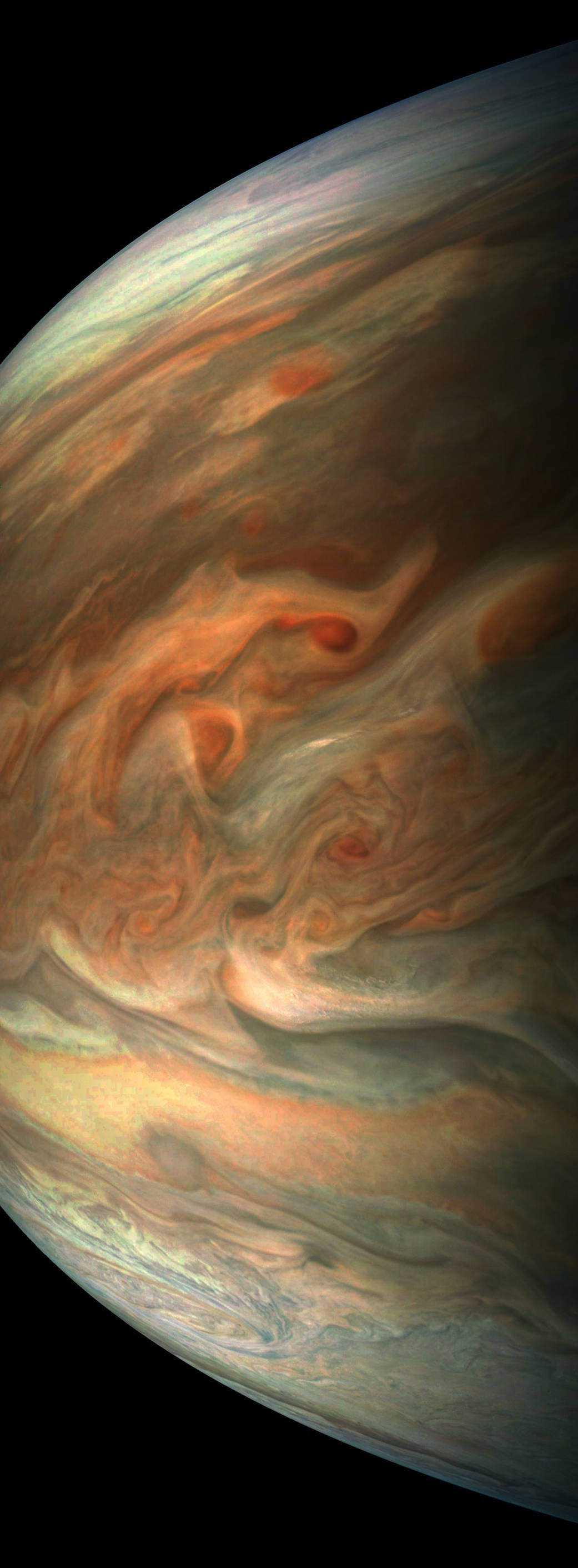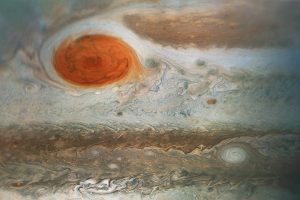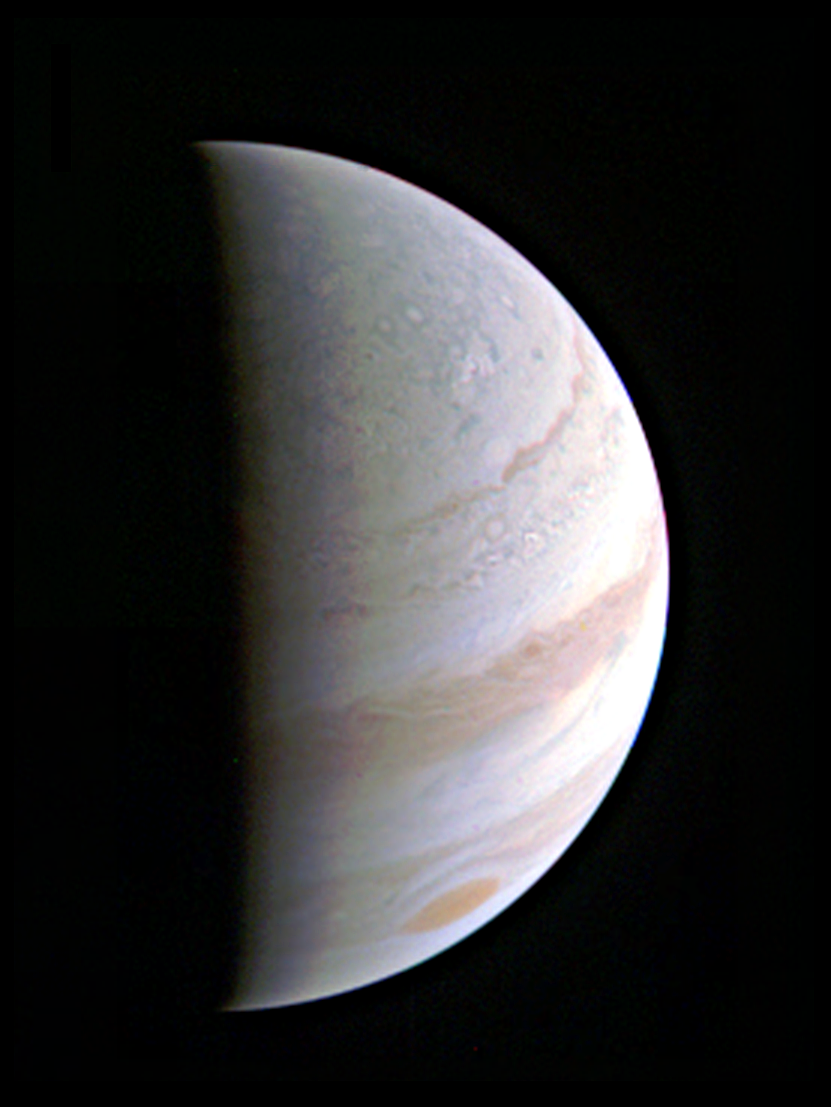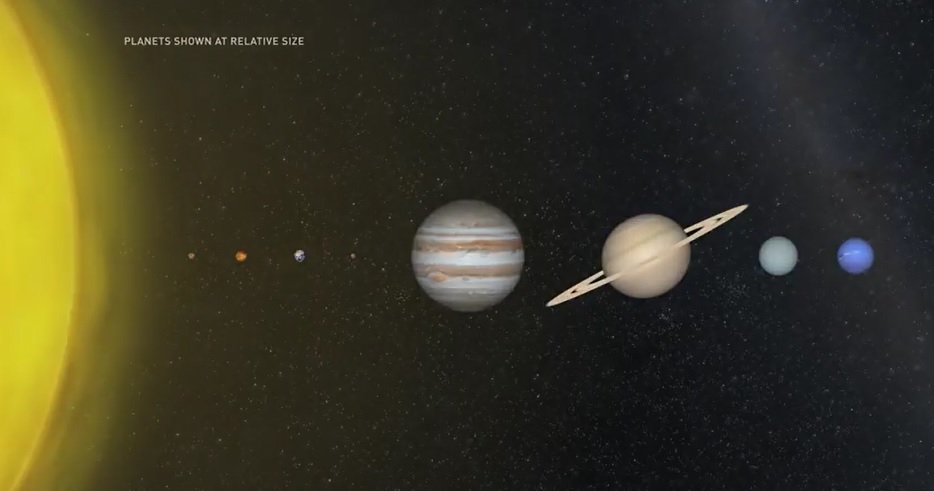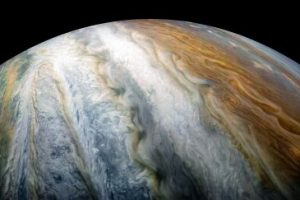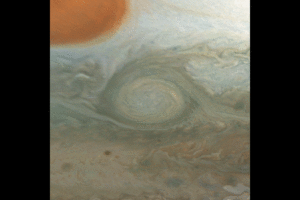Illustration depicts ultraviolet polar aurorae on Jupiter and Earth
This illustration depicts ultraviolet polar aurorae on Jupiter and Earth. While the diameter of the Jovian world is 10 times larger than that of Earth, both planets have markedly similar aurora.
Credits: NASA/JPL-Caltech/SwRI/UVS/STScI/MODIS/WIC/IMAGE/ULiège
木星と地球の紫外線極オーロラの画像です。
この画像は、木星と地球の紫外線極オーロラを示しています。木星は地球の直径の10倍ですが、両方の惑星のオーロラは著しく類似しています。
上記の図の説明にありますように、木星と地球のオーロラの説明をするために、地球のサイズを木星に合わせて拡大表示しています。
地球と木星の磁気圏は、成り立ちや構成が全く違うものであるのに、そこで現れる磁気嵐であるオーロラが驚くほど似た特徴を持っているとNASAは伝えています。
NASA公式サイトのURLはこちら:
NASA’s Juno Reveals Dark Origins of One of Jupiter’s Grand Light Shows | NASA
以下はオリジナル原文と和訳です。
NASA’s Juno Reveals Dark Origins of One of Jupiter’s Grand Light Shows
The gas-giant orbiter is illuminating the provenance of Jovian polar light shows.
木星を周回している探査機が、木星の極で繰り広げられる光のショーがどこから生じているのかを明らかにします。
New results from the Ultraviolet Spectrograph instrument on NASA’s Juno mission reveal for the first time the birth of auroral dawn storms – the early morning brightening unique to Jupiter’s spectacular aurorae. These immense, transient displays of light occur at both Jovian poles and had previously been observed only by ground-based and Earth-orbiting observatories, notably NASA’s Hubble Space Telescope. Results of this study were published March 16 in the journal AGU Advances.
NASAのジュノーミッションでの紫外線スペクトログラフ装置からの新らしデータは、オーロラとして輝く夜明けの嵐の誕生を初めて明らかにしますーこの早朝の光り輝く現象は、木星の壮観なオーロラに特有のものです。これらの巨大ですがすぐに消えてしまうオーロラは、木星の両極で発生し、以前は地上の天文台と地球を周回する観測装置、特にNASAのハッブル宇宙望遠鏡によってのみ観測されていました。この観測結果は、3月16日にジャーナルAGU Advances誌に掲載されました。
First discovered by Hubble’s Faint Object Camera in 1994, dawn storms consist of short-lived but intense brightening and broadening of Jupiter’s main auroral oval – an oblong curtain of light that surrounds both poles – near where the atmosphere emerges from darkness in the early morning region. Before Juno, observations of Jovian ultraviolet aurora had offered only side views, hiding everything happening on the nightside of the planet.
1994年にハッブルの微光カメラによって最初に発見された夜明けの嵐は、短命であるが強烈な明るさと広がりで構成されていて、木星の主なオーロラ(両極を囲む長方形の光のカーテンのような)は、夜明けのまだ暗いところから出てくる大気近辺に存在します。ジュノーで観測する前は、木星の紫外線オーロラ観測は、木星の夜側で起こっている現象は全て見ることができず、側面しか観測することができていませんでした。
“Observing Jupiter’s aurora from Earth does not allow you to see beyond the limb, into the nightside of Jupiter’s poles. Explorations by other spacecraft – Voyager, Galileo, Cassini – happened from relatively large distances and did not fly over the poles, so they could not see the complete picture,” said Bertrand Bonfond, a researcher from the University of Liège in Belgium and lead author of the study. “That’s why the Juno data is a real game changer, allowing us a better understanding what is happening on the nightside, where the dawn storms are born.”
「地球から木星のオーロラを観測しても、木星の極の夜になっている暗い部分の内側を見ることができません。ジュノー以外の他の探査機(ボイジャー、ガリレオ、カッシーニ)は、比較的木星の極の遠方から観測しただけであり、極の上を飛行しなかったため、全体像を見ることができませんでした」と、ベルギーのリエージュ大学の研究者で筆頭著者のバートランドボンフォンドは述べています。 「だからこそ、ジュノーの観測データはまさにゲームチェンジャーであり、夜明けの嵐が発生する夜側で何が起こっているのかをよりよく理解することができます。」
Researchers found dawn storms are born on the nightside of the gas giant. As the planet rotates, the soon-to-be dawn storm rotates with it into the dayside, where these complex and intensely bright auroral features grow even more luminous, emitting anywhere from hundreds to thousands of gigawatts of ultraviolet light into space. The jump in brightness implies that dawn storms are dumping at least 10 times more energy into Jupiter’s upper atmosphere than typical aurora.
研究者たちは、夜明けの嵐が木星の夜になっている側で発生していることを発見しました。木星が回転することで、間もなく夜明けの嵐も回転して昼の側に入ります。そこでは、これらの複雑で非常に明るいオーロラの特徴がさらに明るくなり、数百から数千ギガワットの紫外線を宇宙空間に放出します。明るさの急上昇は、夜明けの嵐が木星の大気上層部に標準的なオーロラより、少なくとも10倍も多いエネルギーを放出していることを意味しています。
This video clip depicts the evolution of a dawn storm in Jupiter’s polar aurorae. The imagery for the video was collected using data from the from the Ultraviolet Spectrograph instrument aboard NASA’s Juno spacecraft.
Credits: NASA/JPL-Caltech/SwRI/UVS/ULiège
この動画は、木星の極のオーロラにおける夜明けの嵐の進化を描いています。動画にしている元画像は、NASAのジュノー探査機に搭載された紫外線スペクトログラフ機器により観測したデータを使用しています。
“When we looked at the whole dawn storm sequence, we couldn’t help but notice that they are very similar to a type of terrestrial auroras called substorms,” said Zhonghua Yao, co-author of the study at the University of Liège.”
「夜明けの嵐の動き全体を見ると、それらが磁気圏嵐と呼ばれる地球のオーロラに非常に似ていることに気づかずにはいられませんでした」とリエージュ大学の研究の共著者であるZhonghuaYaoは述べています。
Substorms result from brief disturbances in the Earth’s magnetosphere – the region of space controlled by the planet’s magnetic field – that release energy high into the planet’s ionosphere. The similarity between terrestrial and Jovian substorms is surprising because the magnetospheres of Jupiter and Earth are radically different. On Earth, the magnetosphere is essentially controlled by the interaction of the solar wind – the stream of charged particles flowing from the Sun – with Earth’s magnetic field. Jupiter’s magnetosphere is mostly populated by particles escaping from the volcanic moon Io, which then get ionized and trapped around the gas giant via its magnetic field.
磁気圏嵐は、地球の磁場(地球の磁力によって影響される空間領域)の短時間の擾乱から生じ、地球の電離層に高いエネルギーを放出します。木星と地球の磁気圏は根本的に異なるものであるにもかかわらず、地球と木星の磁気圏嵐の類似性は驚くべきものです。地球上の磁気圏は、基本的に太陽風(太陽から流れる荷電粒子の流れ)と地球の磁場との相互作用によって制御されます。木星の磁気圏は、ほとんどの場合、火山の衛星イオから飛来してきている粒子で占められており、その粒子は木星の磁場によりイオン化され、木星の周囲に漂うことになります。
These new findings will allow scientists to further study the differences and similarities driving the formation of aurora, providing a better understanding how these most beautiful of planetary phenomena occur on worlds both within our solar system and beyond.
これらの新しい発見により、科学者はオーロラの形成を促進する相違点と類似点をさらに研究することができ、これらの惑星現象の中でも最も美しいものが、太陽系の内外でどのように発生するかをよりよく理解できます。
“The power that Jupiter possesses is amazing. The energy in these dawn aurorae is yet another example of how powerful this giant planet really is,” said Scott Bolton, principal investigator of Juno from the Southwest Research Institute in San Antonio. “The dawn storm revelations are another surprise from the Juno mission, which is constantly rewriting the book on how giant planet’s work. With NASA’s recent mission extension, we’re looking forward to many more new insights and discoveries.”
「木星が持つ力は驚くべきものです。これらの夜明けのオーロラのエネルギーは、この巨大な惑星が実際にどれほど強力であるかを示すもう1つの例です」とサンアントニオのサウスウエスト研究所のジュノー主任研究員であるスコットボルトンは述べています。 「夜明けの嵐の啓示は、巨大惑星の働きについての本を絶えず書き直しているジュノーミッションからのもう1つの驚きです。 NASAの最近のミッション拡張により、さらに多くの新しい洞察と発見を楽しみにしています。」
More About the Mission
JPL, a division of Caltech in Pasadena, California, manages the Juno mission for the principal investigator, Scott J. Bolton, of the Southwest Research Institute in San Antonio. Juno is part of NASA’s New Frontiers Program, which is managed at NASA’s Marshall Space Flight Center in Huntsville, Alabama, for the agency’s Science Mission Directorate in Washington. Lockheed Martin Space in Denver built and operates the spacecraft.
More information about Juno is available at:
Follow the mission on Facebook and Twitter at:
https://www.facebook.com/NASASolarSystem
DC Agle
Jet Propulsion Laboratory, Pasadena, Calif.
818-393-9011
agle@jpl.nasa.gov
Grey Hautaluoma / Alana Johnson
NASA Headquarters, Washington
202-358-0668 / 202-358-1501
grey.hautaluoma-1@nasa.gov / alana.r.johnson@nasa.gov
Deb Schmid
Southwest Research Institute, San Antonio
210-522-2254
dschmid@swri.org
2021-056Last Updated: Mar 17, 2021
Editor: Tony Greicius
